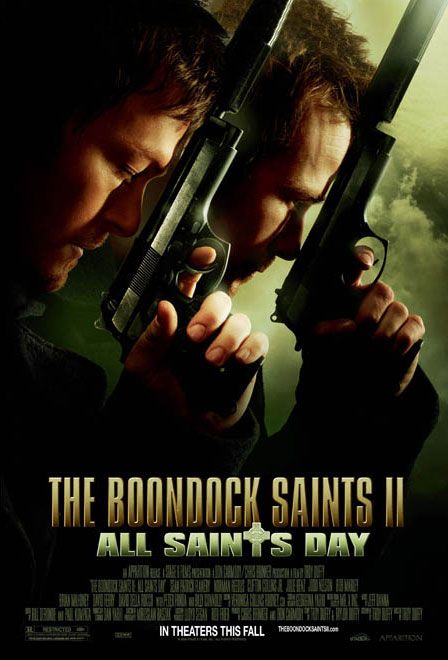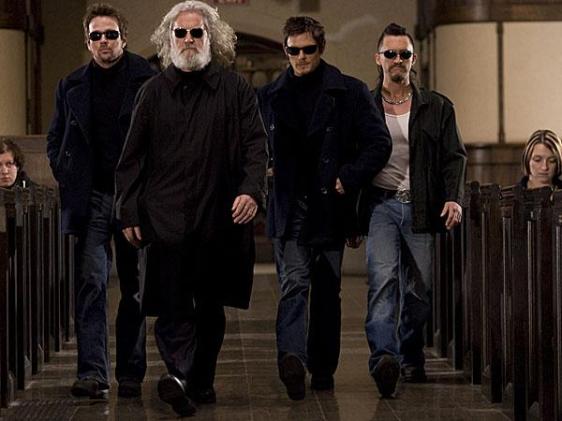And Shepherds we shall be, for Thee, my Lord, for Thee.
Power hath descended forth from Thy hand,
that our feet may swiftly carry out Thy command.
So we shall flow a river forth to Thee,
and teeming with souls shall it ever be.
In Nomine Patris, et Filii, et Spiritus Sancti.
Spoiler warning: This review will contain spoilers for the original Boondock Saints film.
Troy Duffy’s 1999 film The Boondock Saints got a meager theatrical release, mostly owing to its proximity and minor resemblance to the Columbine High School shootings, but found quite a cult following on DVD. And my friends and I absolutely ate it up. Along with Richard Kelly’s Donnie Darko, this was my indie darling in high school. And oh, to be 15 again. To live in a cinematic world where heaven is a slow-motion shootout of dual silenced pistols, exploding cats, and gratuitous silicone tits, and where the best thing that can happen to a good movie is a sequel with an increased budget.
The Boondock Saints 2: All Saints’ Day, whose subtitle makes about as much sense as that of Die Hard 2, has more or less the same plot as the first film. Mobsters are bad, Jesus is good (kinda), and the McManus brothers – Connor (Sean Patrick Flanery) and Murphy (Norman Reedus), along with their father, Il Duce (Billy Connolly), and brand new Mexican sidekick, Romeo (Clifton Collins, Jr.), are anointed by God and cinema to wax as many evildoers as possible. With the mob, the Boston PD, and the FBI hot on their trail (after a very public mobster killing at the end of the first film), the boys must survive using only their wits, their guns, and their uncanny ability to avoid all return fire while sitting immobile on their haunches flailing their gun-arms wildly.
In the first film, Willem Dafoe had quite a memorable role as FBI Agent Paul Smecker, and while his investigation of the boys’ carefully delivered crime scenes didn’t make even the slightest bit of pop-forensic sense, it produced some of the most fun scenes in that film. Blaring opera music through his portable CD player, he cavorted omnisciently around each set piece reconstructing the crime in his mind, during which we saw flashbacks of that very crime in progress (since we only knew as much as he did by then). It was a silly, but effective storytelling device in that film.
After ten years, Willem Dafoe has gone on to bigger and…erm…better…things, and Paul Smecker has been replaced by Special Agent Eunice Bloom (Dexter‘s Julie Benz). She does the same superficial dance as Dafoe around the crime-scene, sporting earplugs instead of headphones (seemingly to block out the Boston PD’s endless cavalcade of incompetence and sexual harassment), and can miraculously reconstruct a perfect timeline of grisly events. But while Benz looks gorgeous as a redhead and is clearly having a great deal of fun in this role, her fake southern drawl is downright repellent, and she just comes off as a ham-fisted (and mostly unsuccessful) attempt to recapture the fun of Dafoe’s character.
In much the same way, Clifton Collins, Jr., one of the most talented and prolific character actors in Hollywood, has joined the party as the Saints’ new bumbling non-Irish sidekick, Romeo. The boys refer to Romeo as “[their] Mexican”, Collins’ mulleted, mustachioed, tattooed madman is utterly cartoonish, and yet an absolute pleasure to behold. His initial meeting with the Saints on the boat-ride from Ireland provokes the kind of instant acceptance seldom seen outside of a Dungeons and Dragons match (“You seem trustworthy!”). This character is ridiculous, but immensely fun.
But Romeo is really just a replacement sidekick for the Saints, following the departure (from this mortal coil) of their old buddy David Della Rocco (David Della Rocco). But don’t you worry, fans, Rocco may be dead, but he’s not gone. In the middle of the film…practically in the middle of a shootout, in fact, it suddenly and inexplicably cuts away to the boys sitting in an Irish pub, with Rocco behind the bar pouring them shots. The scene jumps wildly around from the bar to a downtown Boston [read: Toronto] rooftop, and finally to a hockey rink, as Rocco gives a blaringly incoherent, Denis Learyesque rant about what it means to be a man, and what a man should do (“things” is apparently the answer). The scene makes absolutely no sense, interrupts the flow of an already overlong film, and may be the worst example of pandering fan-service ever seen put to screen.
As for the Saints themselves, what can I really say? They’re back and doing their thing, and it’s basically the same as before, except they just look a bit more tired and deliver their awesome killing prayer (above) a lot more robotically. And while it seems Flanery and Reedus have aged about 15 years in the ensuing 10, Billy Connolly looks like he may have actually gotten younger, and the film tries to expand upon his character by giving Il Duce, the scourge of the Boston mob, his very own origin story. We can tell it’s a flashback because of the desaturated color (a trope I truly never get tired of), and Il Duce’s backstory is at least marginally interesting. Some mobsters killed his boss, he goes to kill mobsters, he realizes he likes killing mobsters, his buddy betrays him and then comes back for revenge (Yes, you read that correctly), and so on. There was a time when I might have found this story more compelling, but a decade and four seasons of Dexter later, all it inspired was a tepid yawn. His back story amounts to a fairly simplistic (and yet strangely incoherent) revenge and serial killer tale, and just comes off as padding a shallow film with needless exposition.
As a continuing fan of the first film who can admit that it’s actually not that good, I can’t see much here that justifies the sequel’s existence. It just feels like a ten-year reunion of callbacks to the first film, as reenacted by a high school drama department. The thoroughly engrossing soundtrack of grand, over-epic requiems and Celtic jigs has been abandoned in favor of abrasive and extremely generic rock music. In one scene, the music blares over Connor McManus sprouting a notable gun-boner over a pair of monstrous black pistols, with the lyrics inviting me to go “BALLS DEEP, MOTHERFUCKER!!!”. Sound advice.
As you might’ve guessed, even as a shadow of its predecessor, there is a meager amount to enjoy in The Boondock Saints II, as long as you’ve not strayed past a certain threshold of emotional maturity. This film definitely has all the ingredients of a high schooler’s “cult classic”, but I can only hope that if Troy Duffy returns after another decade-long hiatus to make The Boondock Saints III-D, a few of them might see the error of their ways.
FilmWonk rating: 3 out of 10
(mercifully, this was also the price of my ticket)



I have to say, I continually thoroughly reading these reviews on your website. Along with being very detailed, and also with some words I have to look up in the dictionary peridically, I very much enjoy the humor embedded in them. The “Balls deep, motherfucker!” addition was quite funny.
Your Bro